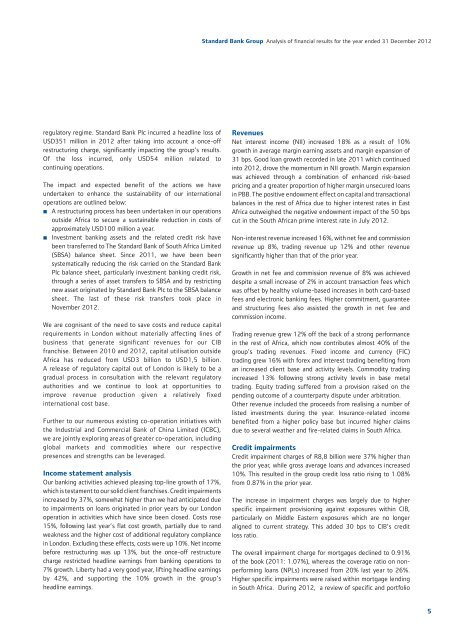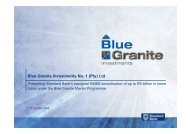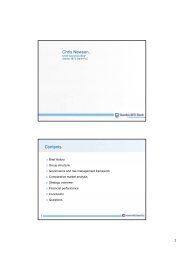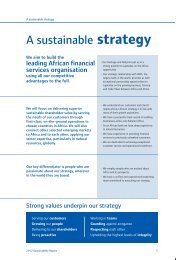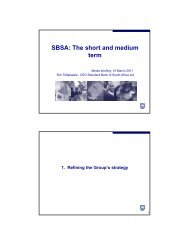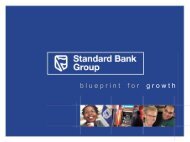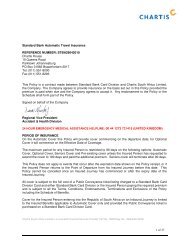Standardbank Cover.indd - Standard Bank - Investor Relations
Standardbank Cover.indd - Standard Bank - Investor Relations
Standardbank Cover.indd - Standard Bank - Investor Relations
You also want an ePaper? Increase the reach of your titles
YUMPU automatically turns print PDFs into web optimized ePapers that Google loves.
<strong>Standard</strong> <strong>Bank</strong> Group Analysis of financial results for the year ended 31 December 2012<br />
regulatory regime. <strong>Standard</strong> <strong>Bank</strong> Plc incurred a headline loss of<br />
USD351 million in 2012 after taking into account a once-off<br />
restructuring charge, significantly impacting the group’s results.<br />
Of the loss incurred, only USD54 million related to<br />
continuing operations.<br />
The impact and expected benefit of the actions we have<br />
undertaken to enhance the sustainability of our international<br />
operations are outlined below:<br />
• A restructuring process has been undertaken in our operations<br />
outside Africa to secure a sustainable reduction in costs of<br />
approximately USD100 million a year.<br />
• Investment banking assets and the related credit risk have<br />
been transferred to The <strong>Standard</strong> <strong>Bank</strong> of South Africa Limited<br />
(SBSA) balance sheet. Since 2011, we have been been<br />
systematically reducing the risk carried on the <strong>Standard</strong> <strong>Bank</strong><br />
Plc balance sheet, particularly investment banking credit risk,<br />
through a series of asset transfers to SBSA and by restricting<br />
new asset originated by <strong>Standard</strong> <strong>Bank</strong> Plc to the SBSA balance<br />
sheet. The last of these risk transfers took place in<br />
November 2012.<br />
We are cognisant of the need to save costs and reduce capital<br />
requirements in London without materially affecting lines of<br />
business that generate significant revenues for our CIB<br />
franchise. Between 2010 and 2012, capital utilisation outside<br />
Africa has reduced from USD3 billion to USD1,5 billion.<br />
A release of regulatory capital out of London is likely to be a<br />
gradual process in consultation with the relevant regulatory<br />
authorities and we continue to look at opportunities to<br />
improve revenue production given a relatively fixed<br />
international cost base.<br />
Further to our numerous existing co-operation initiatives with<br />
the Industrial and Commercial <strong>Bank</strong> of China Limited (ICBC),<br />
we are jointly exploring areas of greater co-operation, including<br />
global markets and commodities where our respective<br />
presences and strengths can be leveraged.<br />
Income statement analysis<br />
Our banking activities achieved pleasing top-line growth of 17%,<br />
which is testament to our solid client franchises. Credit impairments<br />
increased by 37%, somewhat higher than we had anticipated due<br />
to impairments on loans originated in prior years by our London<br />
operation in activities which have since been closed. Costs rose<br />
15%, following last year’s flat cost growth, partially due to rand<br />
weakness and the higher cost of additional regulatory compliance<br />
in London. Excluding these effects, costs were up 10%. Net income<br />
before restructuring was up 13%, but the once-off restructure<br />
charge restricted headline earnings from banking operations to<br />
7% growth. Liberty had a very good year, lifting headline earnings<br />
by 42%, and supporting the 10% growth in the group’s<br />
headline earnings.<br />
Revenues<br />
Net interest income (NII) increased 18% as a result of 10%<br />
growth in average margin earning assets and margin expansion of<br />
31 bps. Good loan growth recorded in late 2011 which continued<br />
into 2012, drove the momentum in NII growth. Margin expansion<br />
was achieved through a combination of enhanced risk-based<br />
pricing and a greater proportion of higher margin unsecured loans<br />
in PBB. The positive endowment effect on capital and transactional<br />
balances in the rest of Africa due to higher interest rates in East<br />
Africa outweighed the negative endowment impact of the 50 bps<br />
cut in the South African prime interest rate in July 2012.<br />
Non-interest revenue increased 16%, with net fee and commission<br />
revenue up 8%, trading revenue up 12% and other revenue<br />
significantly higher than that of the prior year.<br />
Growth in net fee and commission revenue of 8% was achieved<br />
despite a small increase of 2% in account transaction fees which<br />
was offset by healthy volume-based increases in both card-based<br />
fees and electronic banking fees. Higher commitment, guarantee<br />
and structuring fees also assisted the growth in net fee and<br />
commission income.<br />
Trading revenue grew 12% off the back of a strong performance<br />
in the rest of Africa, which now contributes almost 40% of the<br />
group’s trading revenues. Fixed income and currency (FIC)<br />
trading grew 16% with forex and interest trading benefiting from<br />
an increased client base and activity levels. Commodity trading<br />
increased 13% following strong activity levels in base metal<br />
trading. Equity trading suffered from a provision raised on the<br />
pending outcome of a counterparty dispute under arbitration.<br />
Other revenue included the proceeds from realising a number of<br />
listed investments during the year. Insurance-related income<br />
benefited from a higher policy base but incurred higher claims<br />
due to several weather and fire-related claims in South Africa.<br />
Credit impairments<br />
Credit impairment charges of R8,8 billion were 37% higher than<br />
the prior year, while gross average loans and advances increased<br />
10%. This resulted in the group credit loss ratio rising to 1.08%<br />
from 0.87% in the prior year.<br />
The increase in impairment charges was largely due to higher<br />
specific impairment provisioning against exposures within CIB,<br />
particularly on Middle Eastern exposures which are no longer<br />
aligned to current strategy. This added 30 bps to CIB’s credit<br />
loss ratio.<br />
The overall impairment charge for mortgages declined to 0.91%<br />
of the book (2011: 1.07%), whereas the coverage ratio on nonperforming<br />
loans (NPLs) increased from 20% last year to 26%.<br />
Higher specific impairments were raised within mortgage lending<br />
in South Africa. During 2012, a review of specific and portfolio<br />
5


